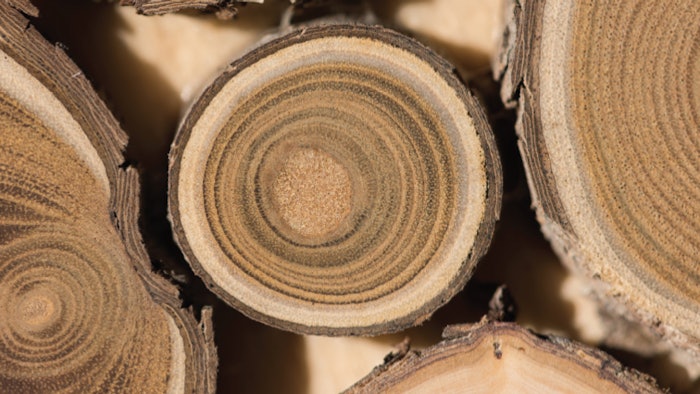
Sandalwood has been valued for thousands of years, used for spiritual practices and incorporated in perfumes, soaps, candles, incense and folk medicines.1, 2 The ancient Egyptians (circa 3,100 B.C.) applied it in mummification, embalming the dead with it, and in ritual burning to honor the gods.2 In India, it also was utilized during funeral ceremonies, where it was placed in a censer at the feet of the deceased to allow the soul to rise.3 In fact, the aroma of the oil and the wood is esteemed by people belonging to three major world religions: Hinduism, Buddhism and Islam.2
The word Santalum is originally derived from the Sanskrit Chandana, meaning “word for burning incense.”4 The tree is indigenous to tropical regions of India, Malay Archipelago and northern Australia but it made its way to other regions through incense trade, among other means.4 Sandalwood trees reach approx. 33 feet (10 meters) in height, have leathery leaves that grow in pairs, and are partially parasitic on the roots of other tree species.1
Sandalwood refers specifically to wood from trees of the genus Santalum and differs from other aromatic woods in that it can retain its fragrance for years, even decades. The unique, familiar scent is described as soft, warm, smooth, creamy and milky, and is emitted by both the wood and its extracted oil.4 Both the tree and roots contain the fragrant yellow oil,1 which typically is extracted by steam distillation of the heartwood powder.2 It takes at least 15 years or more for trees to produce high levels of fragrance oils and consequently, some species have suffered from over-harvesting.4
Of all the species, Santalum album is considered to have the best original quality for religious and traditional medical although it is a threatened species. As an alternative, Australian sandalwood, Santalum spicatum, is marketed for its stable sourcing and is used by aromatherapists and perfumers.4
Related: Indian Sandalwood Oil Is a Potent Antioxidant
Traditional and Modern Uses
In addition to incense, the wood is used by spiritual practitioners as a paste that is applied to the necks, forearms and chests to protect the skin. The paste is prepared by grinding wood by hand against granite slabs and adding water. It is then mixed with saffron or other pigments, herbs and perfumes.4
According to Healthline, East Indian sandalwood oil has been used in ayurvedic medicine and traditional Chinese medicine alongside other therapies to help manage the common cold, urinary tract infections, liver and gallbladder problems, and treat digestive and muscle issues, mental disorders, hemorrhoids and scabies.5 Ayurveda describes its use for ailments such as diarrhea, vomiting, urticaria, eye infections and more.6
In more modern times, it has been used for its sedative effects and astringent activity, making it useful as a disinfectant, and as a diuretic, expectorant and stimulant. Additional applications include as a tonic for heart, stomach and liver, an anti-poison, for fever and memory improvement and a blood purifier.6,7 Recent research suggests sandalwood may provide anti-inflammatory, anti-anxiety, wound healing, anti-skin cancer and antibacterial benefits.5, 8
Read more about the skin benefits of sandalwood in March's Digital Magazine...
Rachel Grabenhofer is the managing scientific editor of Cosmetics & Toiletries, Skin Inc.’s sister brand for cosmetic chemists. She’s a member of the Skin Microbiome Council and Society of Cosmetic Chemists, and for several years, led judging panels to honor the best ingredients in cosmetics.











